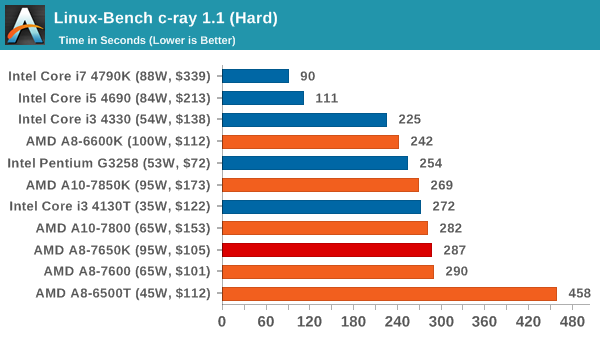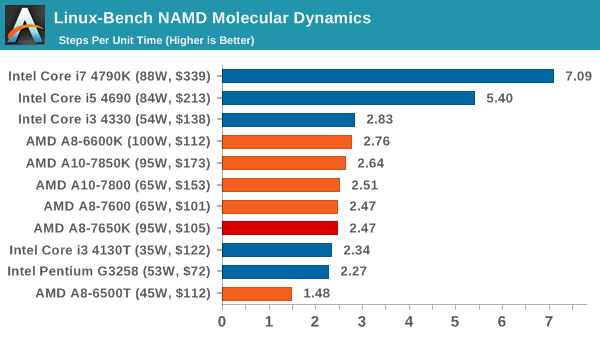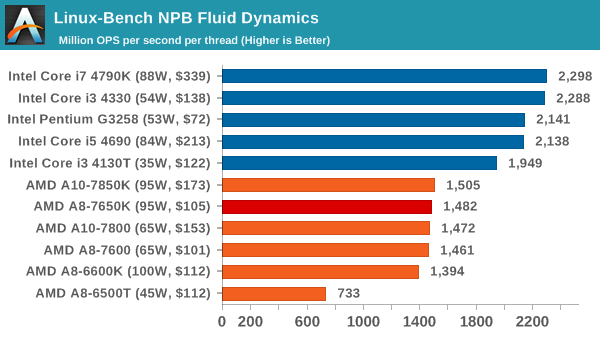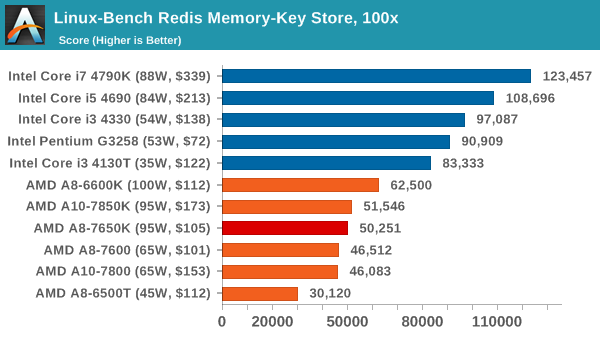The AMD A8-7650K APU Review, Also New Testing Methodology
by Ian Cutress on May 12, 2015 10:00 AM ESTProfessional Performance: Linux
Built around several freely available benchmarks for Linux, Linux-Bench is a project spearheaded by Patrick at ServeTheHome to streamline about a dozen of these tests in a single neat package run via a set of three commands using an Ubuntu 11.04 LiveCD. These tests include fluid dynamics used by NASA, ray-tracing, OpenSSL, molecular modeling, and a scalable data structure server for web deployments. We run Linux-Bench and have chosen to report a select few of the tests that rely on CPU and DRAM speed.
C-Ray: link
C-Ray is a simple ray-tracing program that focuses almost exclusively on processor performance rather than DRAM access. The test in Linux-Bench renders a heavy complex scene offering a large scalable scenario.

Being a scaling benchmark, C-Ray prefers threads and seems more designed for Intel.
NAMD, Scalable Molecular Dynamics: link
Developed by the Theoretical and Computational Biophysics Group at the University of Illinois at Urbana-Champaign, NAMD is a set of parallel molecular dynamics codes for extreme parallelization up to and beyond 200,000 cores. The reference paper detailing NAMD has over 4000 citations, and our testing runs a small simulation where the calculation steps per unit time is the output vector.

NAMD is similar to our office benchmarks, puttin the bulk of the APUs between the i3-4130T and the i3-4330.
NPB, Fluid Dynamics: link
Aside from LINPACK, there are many other ways to benchmark supercomputers in terms of how effective they are for various types of mathematical processes. The NAS Parallel Benchmarks (NPB) are a set of small programs originally designed for NASA to test their supercomputers in terms of fluid dynamics simulations, useful for airflow reactions and design.

Despite the rated memory on the APUs being faster, NPB seems to require more IPC than DRAM speed.
Redis: link
Many of the online applications rely on key-value caches and data structure servers to operate. Redis is an open-source, scalable web technology with a b developer base, but also relies heavily on memory bandwidth as well as CPU performance.











177 Comments
View All Comments
jabber - Tuesday, May 12, 2015 - link
Exactly."Yayyyy I use 7Zip all day long! "
Said no one...ever.
I don't even know why people still compact files? Are they still using floppies? Man, poor devils.
Gigaplex - Tuesday, May 12, 2015 - link
I've been getting BSODs lately due to a bad Windows Update. The Microsoftie asked me to upload a complete memory crash dump. There's no way I can upload a 16GB dump file in a reasonable timeframe on a ~800kbps upload connection, especially when my machine BSODs every 24 hours. Compression brought that down to a much more manageable 4GB.galta - Tuesday, May 12, 2015 - link
So it makes perfect sense for yoy to stay with AMD...NeatOman - Wednesday, May 13, 2015 - link
I use it everyday :( rocking a FX-8320@4.5Ghz for the last 3 years.. I picked it up for $180 with the CPU and!! Motherboard. I was about to pick up a 3770k too, saved about $200 but am about 15-20% down on performance. And if you're worried about electrical cost, you're walking over dollars to pick up pennies.I do it to send pictures of work I do, and a good SSD is key :)
UtilityMax - Tuesday, May 12, 2015 - link
If you look at the WinRAR benchmark, then that result strongly suggests that WinRAR is multi-threaded. I mean, two core two thread Pentium is clearly slower than the two core but four thread Core i3, and quad-core i5 is clearly faster than Core i3, and Core i7 with its eight threads is clearly faster than Core i5. Hence galta's comment that AMD FX with 8 cores is probably even faster, but he says that this is not normal usage.TheJian - Thursday, May 14, 2015 - link
There is an actual checkbox in winrar for multithreading for ages now. ROFL. 95% of usenet uses winrar, as does most of the web. That doesn't mean I don't have 7zip installed, just saying it is only installed for the once in 6 months I find a file that uses it.You apparently didn't even read what he said. He clearly states he's using winrar and finds FX is much faster using 8 cores of FX in winrar. You're like, wrong on all fronts. He's using winrar (can't read?), he's using FX (why suggest it? Can't read?) AND there is a freaking check-box to turn on multi-threading in the app. Not sure whether you're shilling for AMD here or 7zip, but...jeez.
galta - Saturday, May 16, 2015 - link
Last AMD CPU I had was the old and venerable 386DX@40Mhz. Where any of you alive back in the early 90s?Ever since I've been using Intel.
Of course there were some brief moments during this time when AMD had the upper hand, but the last it happened was some 10 years ago when Athlom and its two cores were a revolution and smashed Pentium Ds. It's just that during that particular moment I wasn't looking for an upgrade so I've Intel ever since.
Having said that, I have to add that I don't understand why we are spending so much time discussing compression of files.
Of course that the more cores you have the better, and AMD happens to have the least expensive 8 core processor on the market, BUT most users spend something like 0.15% of their time compressing files, making this particular shinny performance irrelevant for most of us.
Because most of other software does not scale so good in multithreading (and for games, it has nothing to do with DX12 as someone said elsewhere), we are most likely interested in performance per core, and Intel clearly has the lead here.
NeatOman - Wednesday, May 13, 2015 - link
Truth is the average user won't be able to tell the difference on a system with a i3 running on a ssd and a A6-7400k on a ssd or even a A10-7850k which would be more direct competition to the i3. I build about 2-4 new Intel and AMD systems a month and the only time I myself notice is when I'm setting them up, after that they all feel relitivly close in speed due to the SSD which was the largest bottleneck to have been overcome in the last 10 years.So Intel might feel snappier but are still not much faster in day to day use of heavy browsing and media consumtion as long as you have enough ram and a decent SSD.
mapesdhs - Tuesday, May 12, 2015 - link
Ian Cutress wrote:> Being a scaling benchmark, C-Ray prefers threads and seems more designed for Intel."
It was never specifically designed for Intel. John told me it was, "...an extremely
small program I did one day to figure out how would the simplest raytracer program
look like in the least amount of code lines."
The default simple scene doesn't make use of any main RAM at all (some systems
could hold it entirely in L1 cache). The larger test is more useful, but it's still wise to
bare in mind to what extent the test is applicable to general performance comparisons.
John confirmed this, saying, "This thing only measures 'floating point CPU performance'
and nothing more, and it's good that nothing else affects the results. A real rendering
program/scene would be still CPU-limited meaning that by far the major part of the time
spent would be CPU time in the fpu, but it would have more overhead for disk I/O, shader
parsing, more strain for the memory bandwidth, and various other things. So it's a good
approximation being a renderer itself, but it's definitely not representative."
As a benchmark though, c-ray's scalability is incredibly useful, in theory only limited by
the no. of lines in an image, so testing a system with dozens of CPUs is easy.
Thanks for using the correct link btw! 8)
Ian.
PS. Ian, which c-ray test file/image are you using, and with what settings? ie. how many
threads? Just wondered if it's one of the stated tests on my page, or one of those defined
by Phoronix. The Phoronix page says they use 16 threads per core, 8x AA and 1600x1200
output, but not which test file is used (scene or sphfract; probably the latter I expect, as
'scene's incredibly simple).
Ian Cutress - Tuesday, May 12, 2015 - link
It's the c-ray hard test on Linux-Bench, usingcat sphfract | ./c-ray-mt -t $threads -s 3840x2160 -r 8 > foo.ppm
I guess saying it preferred Intel is a little harsh. Many programs are just written the way people understand how to code, and it ends up sheer luck if they're better on one platform by default than the other, such as with 3DPM.